The Venus Flytrap: a guide for growing and keeping dionaea
The Venus flytrap (Venus’s fly trap, or Venus fly trap) is native to only the coastal bogs of North and South Carolina. In the wild, it grows in very sandy nutrient-poor soil with constant water seepage. The plant thrives primarily along the margins of bogs where the soil is always damp. It is also considered an opportunist plant, populating open spaces created by wildfire. However, due of fire suppression in the region, other vegetation often outcompetes and crowds out Venus flytraps.
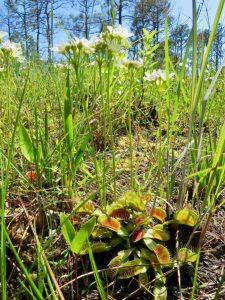
Traveling Through Time: A Brief History of the Venus Fly Trap
On 2 April 1759, the North Carolina colonial governor, Arthur Dobbs, penned the first written description of the plant in a letter to English botanist Peter Collinson. In the letter he wrote: “We have a kind of Catch Fly Sensitive which closes upon anything that touches it. It grows in Latitude 34 but not in 35. I will try to save the seed here.” A year later, Dobbs went into greater detail about the plant in a letter to Collinson dated Brunswick, 24 January 1760.
This was the first detailed recorded notice of the plant by Europeans. The description was before John Ellis’ letter to The London Magazine on 1 September 1768, and his letter to Carl Linnaeus on 23 September 1768, in which he described the plant and proposed its English name Venus’s fly trap and scientific name Dionaea muscipula. A hand-painted engraving by James Roberts of the Venus flytrap, after a design by an unidentified artist, is extant. Roberts’ engraving of the Venus flytrap appeared in 1770 alongside John Ellis’ Instructions for Bringing Seeds and Plants. Its official botanical name, Dionaea muscipula is said to be attributed to Ellis. It is binomially derived from the ancient Greek name for the goddess Dione, mother of Aphrodite, and the Latin compound for a mousetrap, which refers to the plant’s seductive flowers and deadly trapping leaves.
The 1970’s to Present Day
During the 1970s and 1980s, many fly traps sold retail were most likely collected from the wild. As a result, fly trap populations decreased dramatically. By the 1990s, wild collecting of fly traps was strongly discouraged as laboratory cloning techniques developed, allowing specialty nurseries to produce fly traps by the hundreds of thousands each year. As of 2014, poaching fly traps is a felony punishable by 4 years in prison. Since the 1990s, growers have created a plethora of fly trap cultivars. One such variety is Dentate, commonly referred to as Dente. This cultivar has short, triangular interlocking hairs along the edge of the trap, which look like teeth, hence the name. Its leaves have a yellowish hue and grow upright.
A Perennial Flowering Plant
The wild or typical form of Venus flytrap has a broad petiole, a green trap with red interior, and fine interlocking hairs along the edge of the trap. The plant itself is typically 3-5 inches (8-12 cm) in diameter and has 6-8 traps at any one time. Traps are no more than 1 inch (2.5 cm) in length. During peak season (early to late summer), leaves grow upright. By early fall, the plant drops its erect leaves and produces shorter leaves that lie close to the soil surface.
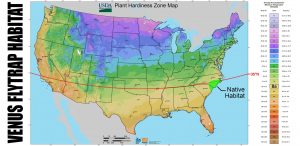
When the temperature slowly warms up and daylight hours grow longer, plants gradually emerge from dormancy. Venus flytraps are typically the last of the cold hardy plants to wake up. In early spring, clip off all leaves from the previous year to make way for flower buds and new leaf growth. Look for flowers in late May to early June. Believe it or not, the Venus flytrap has evolved to possess a towering flower stalk in order to ensure it does not catch its pollinators in its deadly traps!
Many first-time growers are surprised to learn that the Venus flytrap is a cold hardy perennial. As mentioned before, this plant is native to the Carolina coastal plains of the United States. Small populations occur within a 90-mile (145-km) radius that encompasses Wilmington, North Carolina. And yes, it snows there in winter and gets very hot in summer. Venus flytraps typically flower in May through June. Flowers often self pollinate and will produce small, black seeds in August to September.
Where to Grow a Venus Fly Trap
Grow Venus flytraps outdoors as container plant on a sunny deck or patio. You may also grow them in a pond or fountain, but keep the growing point of the plants above water. Venus flytraps share the same growing conditions as cold hardy sundews and Sarracenia. You can grow all three varieties in the same pot to create a wonderful miniature bog garden.
In their natural habitat, these plants experience hot summers and icy winters. During spring and summer, they are in their active growth stage, producing flowers and lots of new leaves. In early fall, they slow down and cease all new growth. By late fall and early winter, much of their spring and summer growth turns brown and dies back. Some plants will maintain a few leaves during winter, but most drop all their leaves and have nothing to show.
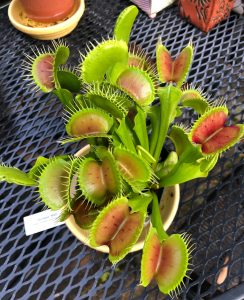
As the weather becomes colder and the days grow shorter, cold hardy plants enter dormancy. During their dormant stage, they can withstand snow and hard freezes (below 25°F or -4°C). They will remain inactive until the weather warms up in spring.
Before growing any cold hardy plant, you should be familiar with your winter climate. The United States Department of Agriculture (USDA) developed a chart to assist farmers with their crops. The chart recognizes 10 zones, each zone based on the lowest recorded temperature. The lower the zone number, the colder and more severe the winters are. This information will help you determine how much winter protection you need to provide for your cold hardy plants.
Heat Tolerance
Flytraps tolerate summer heat very well. They originate from an area where temperatures above 90°F (32°C) commonly occur in summer.
Venus Fly Trap Sunlight Requirements
During the growing season, grow your Venus flytraps outside in full sun. Provide six or more hours of unobstructed, direct sunlight for vigorous growth. (At our nursery in Wilmington, our fly traps receive a minimum of 10 hours of direct sunlight during the growing season.) Partial sun with a minimum of four hours of direct sunlight with bright filtered light during the rest of the day is OK. Growth will be decent, but your plant will not be as vibrant or robust as ones grown in full sun.
Be forewarned: Growing your fly traps exclusively in filtered sun or bright shade for more than a month or two is courting death! Lack of sufficient sunlight is the number one reason why fly traps die. If your plant begins to look sickly in the shade, it is telling you that its current location isn’t bright enough, regardless of what you think. Move it to a sunnier spot.
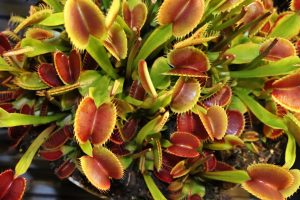
Venus Fly Trap Water Requirements
Many forms of carnivorous plants, such as Sarracenia, Venus flytraps, and sundews, grow in bogs where underground springs continually trickle through the soil. This constant water flow washes away nutrients and allows carnivorous plants to flourish where other plants are not able to. To replicate these wet conditions in cultivation, set your potted plant in a water tray to ensure soil moisture is constant and stable. However, a water tray lacks continuous water flow, and minerals found naturally in the water will eventually accumulate. If the mineral level becomes high enough, it can cause abnormal growth, weakness, and possibly death.
Winter Care
By mid-fall, your plants will slow down in growth and eventually stop growing. They will retain some of their leaves throughout winter, but their leaves will turn brown around the edges, and traps will stop functioning. Flytraps require 3-4 months of winter dormancy triggered by cold temperatures (below 50°F or 10°C) and short daylight hours. Even while dormant, your plants will still need to sit in a small amount of standing water to prevent their soil from drying out. Protecting your flytraps from overnight frosts is often unnecessary. While dormant, flytraps can withstand brief frosts down to 20°F ( -7°C) with no winter protection.
 Early Spring Care
Early Spring Care
When the temperature slowly warms up and daylight hours grow longer, your plants will gradually emerge from dormancy. Venus flytraps are typically the last of the cold hardy plants to wake up. In early spring, clip off all leaves from the previous year to make way for flower buds and new leaf growth. Look for flowers in late May to early June.
Incidentally, some growers insist on clipping off flytrap flowers because of a risk that their plants will die after they flower and set seed. This is only true if flytraps are grown with insufficient lighting. Allowing flytraps to flower in a weakened state will only sap them of vital energy. As long as you grow your flytrap in full sun, you can confidently allow it to flower.
Feeding a Venus fly trap
Keep in mind that insects are little packets of fertilizer and not a source of energy. Although some growers like to feed their flytraps insects, it is not at all necessary. Carnivorous plants have adapted to attract and capture insects on their own. As outdoor plants, flytraps have access to countless insects.
With that said, feeding Venus flytraps is fun! Woohoo! When feeding your plants, feed them only insects and make sure they are small enough to fit into the traps. One insect per plant per week is sufficient. For best results, use fresh, organic, pasture-raised, gluten-free insects. Do not feed your plants meat (or lima beans). Feeding is not at all required during winter when flytraps are dormant.
Repotting a Venus Fly Trap
Repotting is only necessary if you want your flytrap in a larger pot or you need to change the soil to prevent mineral buildup from your tap water. You can transfer your flytraps into fresh soil and a new pot at any time of the year, although late winter to early spring is best while plants are in their early stages of active growth. During summer and early fall, avoid excessive root disturbance by keeping the root ball intact during transfer. For pot size, use one that is large enough to accommodate your plant’s extended root system comfortably. Flytraps tend to grow larger when their roots have room to grow. Large pots will also give your plants added insulation from rapid temperature changes during the winter.
Additional Reading
CarnivorousPlants.co.uk, based in the UK and run by Tom, CarnivorousPlants.co.uk is a carnivorous plant nursery specializing in pitcher plants. The site has fantastic guides on all aspects of cultivation, including advanced topics. Link.
VenusFlyTrapWorld.com contains valuable information and articles describing all aspects of care, watering requirements, and feeding your plant. Link.
Where to Purchase
Our very own Venus Flytrap store offers a bountiful selection of tissue-cultured and seed-grown cultivars for sale. Choose from Giant Flytraps, Classic Flytraps, Red Flytraps, and Saw-Toothed Flytraps. We offer something for every grower, regardless of your level of prior experience.
“The Venus fly trap is one of the most wonderful plants in the world.”
— Charles Darwin

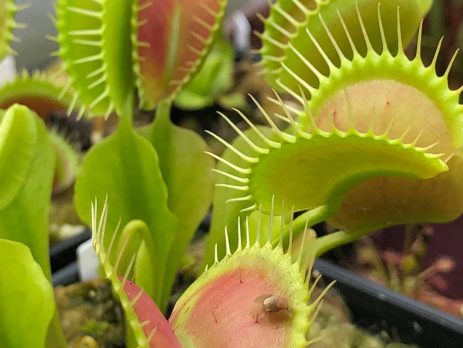
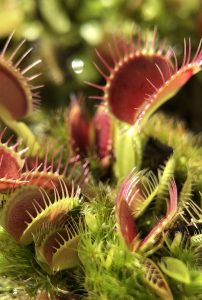 Early Spring Care
Early Spring Care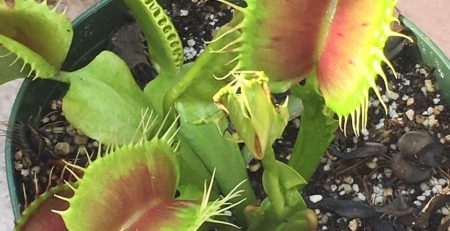
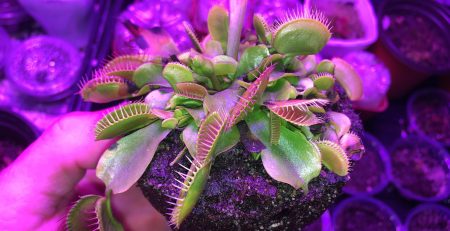
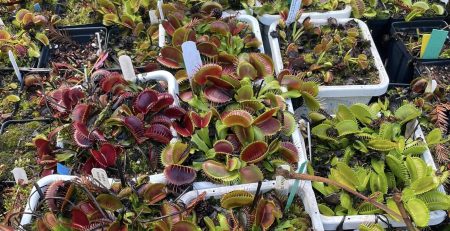
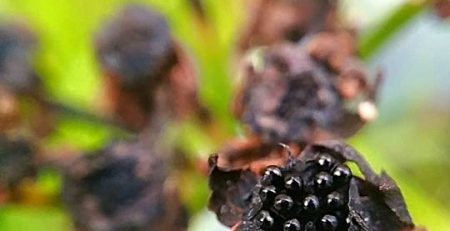
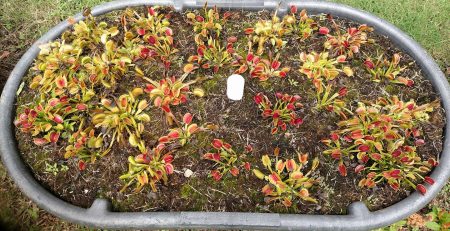
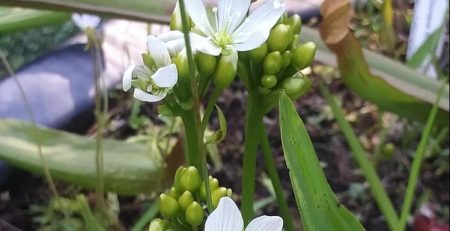
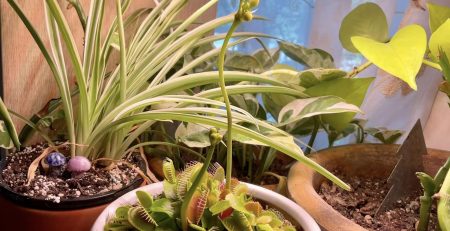
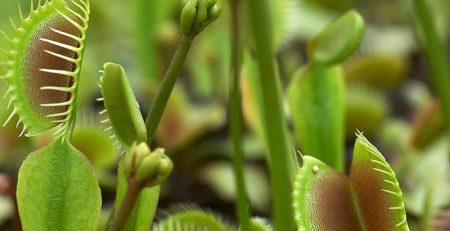
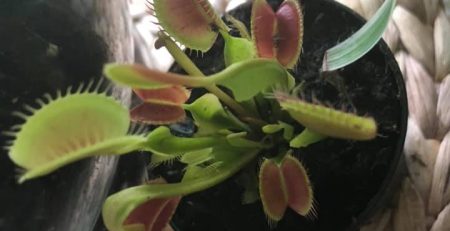
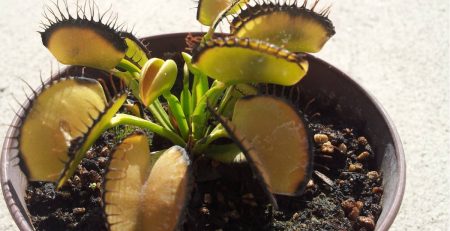
Leave a Reply
You must be logged in to post a comment.